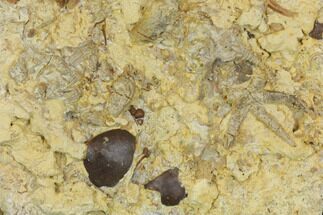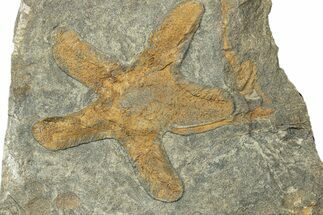This Specimen has been sold.
4.8" Silurian Fossil Trilobite and Brittle Star Plate - New York
Here we have a very uncommon association plate from the Rochester Shale of New York. This beautiful fossil plate includes a Dalmanites limulurus trilobite and a brittle star of the genus Protaster. Isolated brittle stars from the Rochester Shale are fairly rare, but to get one preserved alongside a complete trilobite is something very special. The trilobite measures 2.65" long and the longest measurement of the brittle star is 4.8", both of which are nicely centered on 4.8 x 4.6" slab of shale. This specimen comes out of Caleb's Quarry on the Rochester Shale near Middleport, New York. You won't find many starfish from this site available on the market, let alone an association plate like this.
It comes with an acrylic display stand.
The plate broke into several places upon collection, requiring some significant gap filling of the rock. The brittle star is missing portions of its arms, but has undergone no reconstruction restoration. The trilobite has a restored genal spine (left) and the pygidial spine has been restored. Restoration makes up approximately 4-5% of the trilobite.
It comes with an acrylic display stand.
The plate broke into several places upon collection, requiring some significant gap filling of the rock. The brittle star is missing portions of its arms, but has undergone no reconstruction restoration. The trilobite has a restored genal spine (left) and the pygidial spine has been restored. Restoration makes up approximately 4-5% of the trilobite.
About Dalmanites
Dalmanites is a very visually striking trilobite is one of the classic North American fossils. The distinctive compound eye, believed to be a stereoscopic motion detector, had lenses made of rigid crystal. Its armor, spikes, and visual acuity imply that Dalmanites was trying to keep itself off the menu.
The genus Dalmanites thrived across the globe in a variety of sea conditions and climate. It scanned the Ordivician (488-443 mya) and Silurian (444-415 mya) seas with the good depth perception of its shizochroal eye. Bony and jawed fish emerged in the Silurian, forcing trilobites to adapt or die in a greenhouse world of growing reefs and diverse predators.
The unique shizochroal adaptation of the suborder Phacopina is characterized by up to 700 relatively large, thick lenses made of the purest calcite. A doublet system of mounted lenses within the eye reduced distortion, while perched eyes promoted a wide field of view.
Caleb’s Quarry of Middleport, New York, which quarries the Rochester Shale, is the primary source of richly detailed and well-preserved Dalmanites limulurus as well as over 200 other species that tell the ecological story of the Early Silurian. The famous shale is made from the relic Appalachian Mountains that were uplifted and eroded away into the shallow but deepening, warm seas of the Atlantic.
While the rocks around Lockport, New York have been worked for trilobites since the 1830s, the opening of Caleb's Quarry in 1991 has significantly added to the quantity and quality of the material available. This quarry spends much of the year under water, making work there unquestionably difficult. Many hours of detailed preparation work are required under microscope to extract and repair the trilobites found there.
Dalmanites is a very visually striking trilobite is one of the classic North American fossils. The distinctive compound eye, believed to be a stereoscopic motion detector, had lenses made of rigid crystal. Its armor, spikes, and visual acuity imply that Dalmanites was trying to keep itself off the menu.
The genus Dalmanites thrived across the globe in a variety of sea conditions and climate. It scanned the Ordivician (488-443 mya) and Silurian (444-415 mya) seas with the good depth perception of its shizochroal eye. Bony and jawed fish emerged in the Silurian, forcing trilobites to adapt or die in a greenhouse world of growing reefs and diverse predators.
The unique shizochroal adaptation of the suborder Phacopina is characterized by up to 700 relatively large, thick lenses made of the purest calcite. A doublet system of mounted lenses within the eye reduced distortion, while perched eyes promoted a wide field of view.
Caleb’s Quarry of Middleport, New York, which quarries the Rochester Shale, is the primary source of richly detailed and well-preserved Dalmanites limulurus as well as over 200 other species that tell the ecological story of the Early Silurian. The famous shale is made from the relic Appalachian Mountains that were uplifted and eroded away into the shallow but deepening, warm seas of the Atlantic.
While the rocks around Lockport, New York have been worked for trilobites since the 1830s, the opening of Caleb's Quarry in 1991 has significantly added to the quantity and quality of the material available. This quarry spends much of the year under water, making work there unquestionably difficult. Many hours of detailed preparation work are required under microscope to extract and repair the trilobites found there.
Caleb’s Quarry is in the Rochester Shale Formation, which is a primary source of over 200 richly detailed species that tell the ecologic story of the Early Silurian. This famous strata is known for its especially beautiful and rare assemblage of echinoderms. The calcareous mudstones and grainstones were transported from the relic Appalachian Mountains, which were uplifted and then eroded into the shallow but deepening warm seas of the Atlantic foreland basin during the Early Silurian.
While the rocks around Lockport, NY have been worked for trilobites since the 1830s, the opening of Caleb's quarry in 1991 has significantly added to the quantity and quality of the material available. Working this quarry is unquestionably difficult since it spends much of the year under water. Many hours of detailed preparation under microscope are required to extract and repair the trilobites found there.
Brittle stars are seafloor denizens belonging to the genus Protaster. These echinoderms are ornamented with flexible, whip-like arms that lurched them across the sea floor: one arm would have pressed ahead, while the other four acted as two pairs of opposite levers, thrusting the body forward.
Protaster is in the class Ophiuroidae, which is closely related to starfish. The ophiuroids diverged in the Early Ordovician, about 500 million years ago, resulting in over 2,000 species of brittle stars living today. The Rochester Shale is known for the excellent preservation of Protaster detail in its Lower Silurian strata (425 mya). They often fell apart after death, making a cluster of intact specimens a rare discovery.
There are several fascinating details regarding the Ophiuridoid body plan:
A brittle star's skeleton is made up of embedded ossicles, which are microcrystals of calcite arranged in a three-dimensional lattice known as a stereom. Occicles fuse together into an armor-like test that forms part of the endoskeleton.
The crystals and the spaces between them produce a light and tough honeycomb structure.
Modern Ophiurides establish that Protaster had no eyes or other specialized sense organs. However, they likely had several types of sensitive nerve endings in their epidermis.
Their tube feet might have sensed light as well as odors.
The disk of Protaster contains all of the internal organs that conducted digestion and reproduction.
The underside of the disk contains the mouth, which is also the anus. Ingestion and egestion occur in the same area.
While the rocks around Lockport, NY have been worked for trilobites since the 1830s, the opening of Caleb's quarry in 1991 has significantly added to the quantity and quality of the material available. Working this quarry is unquestionably difficult since it spends much of the year under water. Many hours of detailed preparation under microscope are required to extract and repair the trilobites found there.
Brittle stars are seafloor denizens belonging to the genus Protaster. These echinoderms are ornamented with flexible, whip-like arms that lurched them across the sea floor: one arm would have pressed ahead, while the other four acted as two pairs of opposite levers, thrusting the body forward.
Protaster is in the class Ophiuroidae, which is closely related to starfish. The ophiuroids diverged in the Early Ordovician, about 500 million years ago, resulting in over 2,000 species of brittle stars living today. The Rochester Shale is known for the excellent preservation of Protaster detail in its Lower Silurian strata (425 mya). They often fell apart after death, making a cluster of intact specimens a rare discovery.
There are several fascinating details regarding the Ophiuridoid body plan:
SPECIES
Dalmanites limulurus & Protaster sp.
LOCATION
Caleb's Quarry, Near Middleport, New York
FORMATION
Rochester Shale
SIZE
Plate: 4.8 x 4.6", Trilobite: 2.65" long, Brittle Star: 2" wide (longest measurement)
CATEGORY
SUB CATEGORY
ITEM
#295531
We guarantee the authenticity of all of our specimens.
 Reviews
Reviews













